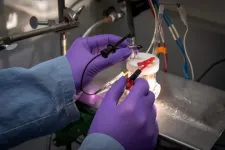(Press-News.org) A new study, out this week, could pave the way to revolutionary, transparent electronics.
Such see-through devices could potentially be integrated in glass, in flexible displays and in smart contact lenses, bringing to life futuristic devices that seem like the product of science fiction.
For several decades, researchers have sought a new class of electronics based on semiconducting oxides, whose optical transparency could enable these fully-transparent electronics.
Oxide-based devices could also find use in power electronics and communication technology, reducing the carbon footprint of our utility networks.
A RMIT-led team has now introduced ultrathin beta-tellurite to the two-dimensional (2D) semiconducting material family, providing an answer to this decades-long search for a high mobility p-type oxide.
"This new, high-mobility p-type oxide fills a crucial gap in the materials spectrum to enable fast, transparent circuits," says team leader Dr Torben Daeneke, who led the collaboration across three FLEET nodes.
Other key advantages of the long-sought-after oxide-based semiconductors are their stability in air, less-stringent purity requirements, low costs and easy deposition.
"In our advance, the missing link was finding the right, 'positive' approach," says Torben.
Positivity has been lacking
There are two types of semiconducting materials. 'N-type' materials have abundant negatively-charged electrons, while 'p-type' semiconductors possess plenty of positively-charged holes.
It's the stacking together of complementary n-type and p-type materials that allows electronic devices such as diodes, rectifiers and logic circuits.
Modern life is critically reliant on these materials since they are the building blocks of every computer and smartphone.
A barrier to oxide devices has been that while many high-performance n-type oxides are known, there is a significant lack of high-quality p-type oxides.
Theory prompts action
However in 2018 a computational study revealed that beta-tellurite (β-TeO2) could be an attractive p-type oxide candidate, with tellurium's peculiar place in the periodic table meaning it can behave as both a metal and a non-metal, providing its oxide with uniquely useful properties.
"This prediction encouraged our group at RMIT University to explore its properties and applications," says Dr Torben Daeneke, who is a FLEET associate investigator.
Liquid metal - pathway to explore 2D materials
Dr Daeneke's team demonstrated the isolation of beta-tellurite with a specifically developed synthesis technique that relies on liquid metal chemistry.
"A molten mixture of tellurium (Te) and selenium (Se) is prepared and allowed to roll over a surface," explains co-first author Patjaree Aukarasereenont.
"Thanks to the oxygen in ambient air, the molten droplet naturally forms a thin surface oxide layer of beta-tellurite. As the liquid droplet is rolled over the surface, this oxide layer sticks to it, depositing atomically thin oxide sheets in its way."
"The process is similar to drawing: you use a glass rod as a pen and the liquid metal is your ink," explains Ms Aukarasereenont, who is a FLEET PhD student at RMIT.
While the desirable β-phase of tellurite grows below 300 °C, pure tellurium has a high melting point, above 500 °C. Therefore, selenium was added to design an alloy that has a lower melting point, making the synthesis possible.
"The ultrathin sheets we obtained are just 1.5 nanometres thick - corresponding to only few atoms. The material was highly transparent across the visible spectrum, having a bandgap of 3.7 eV which means that they are essentially invisible to the human eye" explains co-author Dr Ali Zavabeti.
Assessing beta-tellurite: up to 100 times faster
To assess the electronic properties of the developed materials, field-effect transistors (FETs) were fabricated.
"These devices showed characteristic p-type switching as well as a high hole mobility (roughly 140 cm2V-1s-1), showing that beta-tellurite is ten to one hundred times faster than existing p-type oxide semiconductors. The excellent on/off ratio (over 106) also attests the material is suitable for power efficient, fast devices" Ms Patjaree Aukarasereenont said.
"The findings close a crucial gap in the electronic material library," Dr Ali Zavabeti said.
"Having a fast, transparent p-type semiconductor at our disposal has the potential to revolutionise transparent electronics, while also enabling better displays and improved energy-efficient devices."
The team plans to further explore the potential of this novel semiconductor. "Our further investigations of this exciting material will explore integration in existing and next-generation consumer electronics," says Dr Torben Daeneke.
INFORMATION:
The study
The paper END
Irvine, Calif. -- In 2019, the National Weather Service in Alaska reported spotting the first-known lightning strikes within 300 miles of the North Pole. Lightning strikes are almost unheard of above the Arctic Circle, but scientists led by researchers at the University of California, Irvine have published new research in the journal Nature Climate Change detailing how Arctic lightning strikes stand to increase by about 100 percent over northern lands by the end of the century as the climate continues warming.
"We projected how lightning in high-latitude boreal forests and Arctic ...
An interdisciplinary team led by KU Leuven and Stanford has identified 76 overlapping genetic locations that shape both our face and our brain. What the researchers didn't find is evidence that this genetic overlap also predicts someone's behavioural-cognitive traits or risk of conditions such as Alzheimer's disease. This means that the findings help to debunk several persistent pseudoscientific claims about what our face reveals about us.
There were already indications of a genetic link between the shape of our face and that of our brain, says Professor Peter Claes from the Laboratory for Imaging Genetics at KU Leuven, who is the joint senior author of the study with Professor Joanna Wysocka from the ...
Journal Name: Nature Methods
Title of the Article: Discovering multiple types of DNA methylation from individual bacteria and microbiome using nanopore sequencing
Corresponding Author: Gang Fang, PhD
Bottom Line:
Bacterial DNA methylation occurs at diverse sequence contexts and plays important functional roles in cellular defense and gene regulation. An increasing number of studies have reported that bacterial DNA methylation has important roles affecting clinically relevant phenotypes such as virulence, host colonization, sporulation, biofilm formation, among others.
Bacterial methylomes contain three ...
What The Study Did: A clinical risk assessment tool developed in China was tested with a group of patients in Spain to evaluate its ability to predict critical illness among patients hospitalized with COVID-19 in Europe.
Authors: Oscar Moreno-Perez, M.D., Ph.D., of the Alicante General University Hospital-Alicante Institute of Sanitary and Biomedical Research in Alicante, Spain, is the corresponding author.
To access the embargoed study: Visit our For The Media website at this link https://media.jamanetwork.com/
(doi:10.1001/jamainternmed.2021.0491)
Editor's Note: The article includes conflicts of interest disclosures. Please see the article for additional information, including other authors, author contributions and affiliations, conflict of interest and financial disclosures, and ...
What The Study Did: The 30-day incidence of outpatient and hospital-associated blood clots following SARS-CoV-2 testing among adults in a large health system was examined in this study.
Authors: Nareg H. Roubinian, M.D., of Kaiser Permanente Northern California in Oakland, is the corresponding author.
To access the embargoed study: Visit our For The Media website at this link https://media.jamanetwork.com/
(doi:10.1001/jamainternmed.2021.0488)
Editor's Note: The article includes conflicts of interest and funding/support disclosures. Please see the article for additional information, ...
What The Study Did: Researchers investigated the association of sociodemographic factors and blood group type with the risk of SARS-CoV-2 infection and severity of COVID-19.
Authors: Jeffrey L. Anderson, M.D., of the Intermountain Medical Center Heart Institute in Salt Lake City, is the corresponding author.
To access the embargoed study: Visit our For The Media website at this link https://media.jamanetwork.com/
(doi:10.1001/jamanetworkopen.2021.7429)
Editor's Note: The article includes conflicts of interest disclosures. Please see the ...
What The Study Did: Electronic health record data were used to examine whether the transition to remote cardiology clinic visits during COVID-19 is associated with disparities in patient use of care, diagnostic test ordering and medication prescribing.
Authors: Neal Yuan, M.D., of Cedars-Sinai Medical Center in Los Angeles, is the corresponding author.
To access the embargoed study: Visit our For The Media website at this link https://media.jamanetwork.com/
(doi:10.1001/jamanetworkopen.2021.4157)
Editor's Note: The article includes conflicts of interest and funding/support disclosures. Please see the article for additional information, including other authors, author ...
More snow is melting during winter across the West, a concerning trend that could impact everything from ski conditions to fire danger and agriculture, according to a new University of Colorado Boulder analysis of 40 years of data.
Researchers found that since the late 1970s, winter's boundary with spring has been slowly disappearing, with one-third of 1,065 snow measurement stations from the Mexican border to the Alaskan Arctic recording increasing winter snowmelt. While stations with significant melt increases have recorded them mostly in November and March, the researchers found that melt is increasing in all cold season ...
Three years ago, scientists at the University of Michigan discovered an artificial photosynthesis device made of silicon and gallium nitride (Si/GaN) that harnesses sunlight into carbon-free hydrogen for fuel cells with twice the efficiency and stability of some previous technologies.
Now, scientists at the Department of Energy's (DOE's) Lawrence Berkeley National Laboratory (Berkeley Lab) - in collaboration with the University of Michigan and Lawrence Livermore National Laboratory (LLNL) - have uncovered a surprising, self-improving property in Si/GaN that contributes to the material's highly efficient and stable performance ...
Thousands of our daily activities, from making coffee to taking a walk to saying hello to a neighbor, are made possible through an ancient collection of brain structures tucked away near the center of the cranium.
The cluster of neurons known as the basal ganglia is a central hub for regulating a vast array of routine motor and behavior functions. But when signaling in the basal ganglia is weakened or broken, debilitating movement and psychiatric disorders can emerge, including Parkinson's disease, Tourette's syndrome, attention deficit hyperactivity disorder (ADHD) and obsessive-compulsive ...




